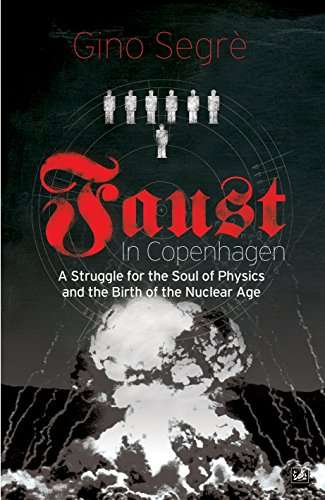
Faust In Copenhagen: A Struggle for the Soul of Physics and the Birth of the Nuclear Age
Check my rate
| Main centres: | 1-3 business days |
| Regional areas: | 3-4 business days |
| Remote areas: | 3-5 business days |

| Main centres: | 1-3 business days |
| Regional areas: | 3-4 business days |
| Remote areas: | 3-5 business days |
Published by Pimlico, 2008, softcover, illustrates, index, 310 pages, condition: as new.
Wonderfully vivid and accessible, this is an account of that moment when the world's greatest physicists came out of the laboratory and onto the international stage - the birth of 'big science' and the nuclear age
"Werner Heisenberg, whose development of matrix mechanics yielded the uncertainty principle, said that one challenge of quantum theory is that it does not have an adequate language beyond mathematics to describe it. Heisenberg comes close to proposing that poetry is that language in Physics and Philosophy when, after making this statement, he immediately references Goethes Faust to describe his understanding of the structure of language. Mephistopheles says that while formal education instructs that logic braces the mind in Spanish boots so tightly laced, and that even spontaneous acts require a sequential process (one, two, three!) .
Heisenberg, while arguing that science must be as attentive to imagination as to logic, also seems to be suggesting that novel sciences must be described by novel languages. Creative endeavors like poetry have the ability to not only describe novel theories and expressions of physical reality, but also to invent them through its shorthand, one treadle moving a thousand lines, where a thousand knots one stroke combines. As I learned in kevin mcpherson eckhoffs rhapsodomancy, the alphabets of the future are wormholes. Since the primary concern in theoretical physics today is reconciling quantum mechanics with relativity through proposals such as string theory, poetry can be thought of as an experiment in physics and physics as a field test for poetry.
Physics is the study of physical reality, which, to my mind, includes spacetime, language, poems, people, consciousness, and agency. In literary terms, string theory could be considered to be a critical theory; it not only describes physical elements, including elementary elements, within spacetime, it attempts to describe spacetime itself. Following in the tradition of Western atomic science from Thales to Democritus, physicists consider the multiverses subatomic, vibrating membranes of energythe open and closed strings of string theoryto be elementary constituents of matter.
What is the significance of these open and closed strings in relation to clinamen occurring in not just artistic contexts but in physical reality, as demonstrated by how probability functions in subatomic phenomena of mechanical systems? Poetry, which could be considered a mutation on physical and conceptual reality, replicates through the ricochet of pattern (periodicity, symmetry, order) and swerve (deviation from pattern, chance) toward novelty, or what might be thought of as the poem itself. Along with the expanding and accelerating multiverse, our understanding and experience of physical reality expands and accelerates at varying scales (subatomic, eye level, astronomical). We create and use technology like our microscopes and telescopes to interact more deeply with these scales, and as such technological advances proliferate so do our capacities to perceive, perform, and create through other mediums. Poetry that is attentive to its multiversal form as a novel technology also operates within and beyond these varying scales through the known and unknown dimensions of physical reality."